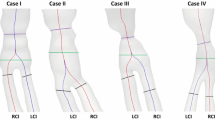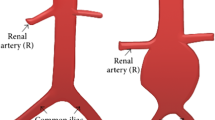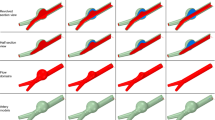Abstract
This paper evaluates numerically coupled blood flow and wall structure interactions in a representative stented abdominal aortic aneurysm (AAA) model, leading potentially to endovascular graft (EVG) failure. A total of 12 biomechanical contributors to possible EVG migration were considered. The results show that after EVG insertion for the given model, the peak AAA sac-pressure was reduced to 14.2 mmHg (11.8% of plumen), and hence the maximum von Mises wall stress and wall deformation dropped by factors of 20 and 10, respectively. Thus, an EVG can significantly reduce sac pressure, mechanical stress, pulsatile wall motion, and the maximum diameter in AAAs and hence prevent AAA rupture effectively. In the absence of endoleaks, elevated sac-pressure can still be caused by fluid-structure interactions between the EVG, stagnant blood, and AAA wall. EVG migration forces vary from 1.4 to 7 N for different EVG geometries, material properties, and hemodynamic conditions. AAA-neck angle, iliac bifurcation angle, neck aorta-to-iliac diameter ratio, EVG size, aorto-uni-iliac EVG, and hypertension play important roles in generating forces potentially leading to EVG migration.
Similar content being viewed by others
References
Beebe HG, Cronenwett JL, Katzen BT, Brewster DC, Green RM (2001) Results of an aortic endograft trial: Impact of device failure beyond 12 months. J Vascular Surgery 33: S55–63
Buchanan JR, Kleinstreuer C, Comer JK (2001) Rheological effects on pulsatile hemodynamics in a stenosed tube. Comput & Fluids 29: 695–724
Chong CK, How TV (2004) Flow patterns in an endovascular EVG for abdominal aortic aneurysm repair. J Biomech 37: 89–97
Di Martino ES, Guadagni G, Fumero A, Ballerini G, Spirito R, Biglioli P, Redaelli A (2001) Fluid-structure interaction within realistic three-dimensional models of the aneurysmatic aorta as a guidance to assess the risk of rupture of the aneurysm. Medical Engineering Phys 23: 647–55
FDA Documents (2003) Zenith Endovascular Graft: Suggested Instructions for Use
Fillinger MF, Marra PS, Raghavan ML, Kennedy EF (2003) Prediction of rupture in abdominal aortic aneurysm during observation: Wall stress versus diameter. J Vascular Surgery 37: 724–732
Finol, EA, Di Martino, ES, Vorp DA, Amon CH (2003) Fluid-structure interaction and structural analyses of an aneurysm model, Proceedings of the ASME 2003 Summer Bioengineering Conference, Key Biscayne, FL, 25–29: 75–76
Flora HS, Talei-Faz B, Ansdell L, Chaloner EJ, Sweeny A, Grass A, Adiseshiah M (2002) Aneurysm wall stress and tendency to rupture are features of physical wall properties: An experimental study. J Endovascular Therapy 9: 665–675
Gawenda M, Jaschke G, Winter S, et al. (2003) Endotension as a result of pressure transmission through the graft following endovascular aneurysm repair - An in vitro study. European J Vascular and Endovascular Surgery. 26: 501–505
Gawenda M, Knez P, Winter S, Jaschke G, Wassmer G, Schmitz-Rixen T, Brunkwall J (2004) Endotension is influenced by wall compliance in a latex aneurysm model. European J Vascular and Endovascular Surgery 27: 45–50
Kalliafas S, Albertini JN, Macierewicz J, Yusuf SW, Whitaker SC, Davidson I, Hopkinson BR (2002) EVG migration after endovascular repair of abdominal aortic aneurysm. J Endovascular Therapy 9:743–747
Lambert AW, Williams DJ, Budd JS, Horrocks M (1998) Experimental assessment of proximal EVG (IntervascularTM) fixation in human cadaveric infrarenal aortas. European J Endovascular Surgery 17: 60–65
Li Z (2005) Computational fluid-structure-interaction analyses applied to stented aneurysms. PhD Thesis. MAE Dept., NC State University, Raleigh, NC, USA
Liffman K, Lawrence M, Semmens B, Bui A, Rudman M, Hartley D (2001) Analytical modeling and numerical simulation of forces in an endoluminal graft. J Endovascular Therapy 8: 358–371
Malina M, Lindblad B, Ivancev K (1998) Endovascular AAA exclusion: Will stents with hooks and barbs prevent EVG migration? J Endovascular Surgery 5: 310–317
Meter O (2000) Numerical simulation and experimental validation of blood flow in arteries with structured-tree outflow conditions. Ann Biomedical Engineering 28: 1281–99
Morris L, Delassus P, Walsh M, McGloughlin T (2004) A mathematical model to predict the in vivo pulsatile migration forces acting on bifurcated stent grafts used in endovascular treatment of abdominal aortic aneurysms (AAA). J biomec 37: 1087–1095
Mohan IV, Harris PL, van Marrewijk CJ, Laheij RJ, How TV (2002) Factors and forces influencing EVG migration after endovascular aortic aneurysm repair. J Endovascular Therapy 9: 748–755
Raghavan M, Vorp D, Federle M, Makaroun M, Webster M (2000) Wall stress distribution on three-dimensionally reconstructed models of human abdominal aortic aneurysm. J Vascular Surgery 31: 760–769
Raghavan ML, Vorp DA (2000) Toward a biomechanical tool to evaluate rupture potential of abdominal aortic aneurysm: identification of a finite strain constitutive model and evaluation of its applicability. J Biomech 33: 475–482
Resch T, Malina M, Lindblad B, Malina J, Brunkwall J, Ivancev K (2000) The impact of stent design on proximal EVG fixation in the abdominal aorta: an experimental study. European J Endovascular Surgery 20: 190–195
Sternbergh WC, Carter G, York JW, Yoselevitz M, Money SR, WC, Carter G, York JW, Yoselevitz M, Money SR (2002)Aortic neck angulation predicts adverse outcome with endovascular abdominal aortic aneurysm repair. J Vascular Surgery 35: 482–486
Sonesson B, Dias N, Malina M, Olofsson P, Griffin D, Lindblad B, Ivancev K (2003) Intra-aneurysm pressure measurements in successfully excluded abdominal aortic aneurysm after endovascular repair. J Vascular Surgery 37: 733–738
Suzuki K, Ishiguchi T, Kawatsu S, Iwai H, Maruyama K, Ishigaki T (2001) Dilatation of EVGs by luminal pressures: experimental evaluation of polytetrafluorothylene (PTFE) and Woven polyester grafts. Cardiovascular and Interventional Radiology 24: 94–98
Thubrikar M, Al-Soudi J, Robicsek F (2001) Wall stress studies of abdominal aortic aneurysm in a clinical model. Ann Vascular Surgery 15: 355–366
Vorp DA, Raghavan M, Webster M (1998) Mechanical wall stress in abdominal aortic aneurysm: influence of diameter and asymmetry. J Vascular Surgery 27: 632–639
Volodos SM, Sayers RD, Gostelow JP, Bell P (2003) Factors affecting the displacement force exerted on a stent graft after AAA repair - An in vitro study. European J Vascular and Endovascular Surgery 26: 596–601
Zarins CK, Arko FR, Crabtree T, Bloch DA, Ouriel K, Allen RC, White RA (2004) Explant analysis of AneuRx stent grafts: Relationship between structural findings and clinical outcome. J Vascular Surgery 40: 1–11
Author information
Authors and Affiliations
Corresponding author
Rights and permissions
About this article
Cite this article
Li, Z., Kleinstreuer, C. & Farber, M. Computational analysis of biomechanical contributors to possible endovascular graft failure. Biomech Model Mechanobiol 4, 221–234 (2005). https://doi.org/10.1007/s10237-005-0003-0
Published:
Issue Date:
DOI: https://doi.org/10.1007/s10237-005-0003-0




